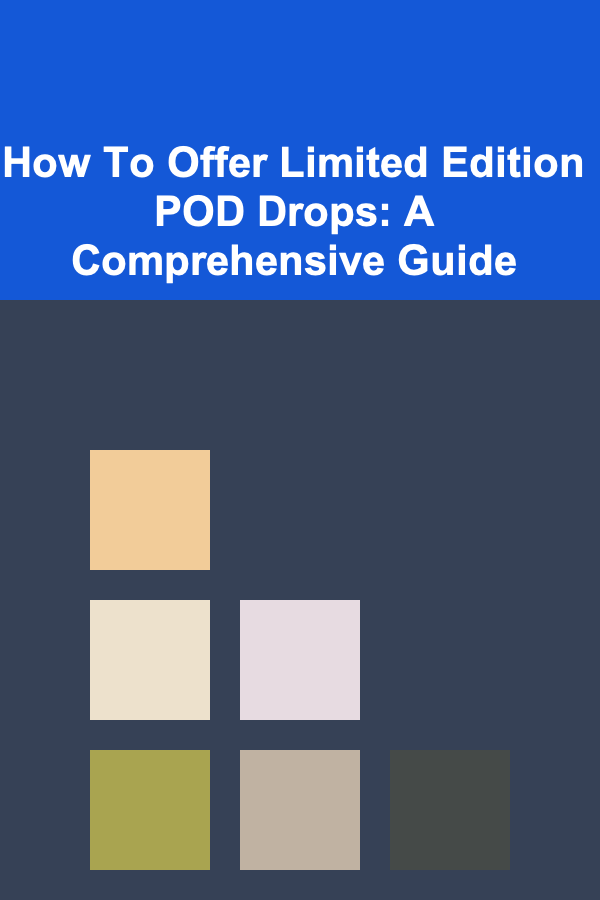
How To Offer Limited Edition POD Drops: A Comprehensive Guide
ebook include PDF & Audio bundle (Micro Guide)
$12.99$11.99
Limited Time Offer! Order within the next:

Print-on-Demand (POD) has revolutionized the e-commerce landscape, allowing creators and entrepreneurs to sell custom-designed products without holding any inventory. However, in a market saturated with POD offerings, standing out and driving sales requires more than just unique designs. One effective strategy is to leverage the power of limited edition drops. By creating a sense of urgency and exclusivity, limited edition POD drops can significantly boost engagement, attract new customers, and generate higher profits. This comprehensive guide will delve into the nuances of crafting and executing successful limited edition POD drops, covering everything from concept development to post-launch analysis.
Understanding the Psychology Behind Limited Edition Drops
Before diving into the practical aspects, it's crucial to understand why limited edition drops work so well. The core principles at play are scarcity, exclusivity, and urgency. These psychological triggers tap into fundamental human desires and motivations:
- Scarcity: Limited quantities create a fear of missing out (FOMO). People are naturally drawn to things that are rare or difficult to obtain. Knowing that a product is available only in a limited number makes it more desirable.
- Exclusivity: Owning a limited edition item makes the buyer feel special and unique. It's a way to express their individuality and belong to a select group of people who possess the same item. This is especially true if the product is associated with a particular artist, brand, or community.
- Urgency: A limited time window to purchase the product compels potential customers to act quickly. The fear of missing out on the opportunity to acquire the item creates a sense of urgency that drives immediate sales.
By strategically incorporating these elements into your POD drops, you can significantly increase their effectiveness and create a buzz around your brand.
Phase 1: Conceptualization and Design
The success of a limited edition POD drop hinges on a compelling concept and eye-catching design. Here's how to approach this crucial phase:
1. Define Your Target Audience
Understanding your target audience is paramount. Consider their interests, preferences, and buying habits. What are they passionate about? What kind of designs resonate with them? The more you know about your audience, the better equipped you'll be to create products they'll love.
Use data from your existing customer base (if you have one), social media insights, and market research to develop detailed buyer personas. This will help you tailor your designs and marketing messages for maximum impact.
2. Brainstorm Theme Ideas
Once you understand your audience, start brainstorming themes that align with their interests. Consider the following approaches:
- Seasonal Themes: Holidays, seasonal changes (e.g., summer vacation, autumn foliage), and special events provide excellent opportunities for limited edition drops.
- Trending Topics: Capitalize on current trends and viral memes. However, be mindful of copyright issues and ensure your designs are original and respectful.
- Collaborations: Partner with other artists, influencers, or brands to create exclusive designs that appeal to both of your audiences.
- Fan Art (with permission!): If you are a fan artist, make sure you have express permission to use characters and likenesses. Otherwise you can focus on creating art INSPIRED by the fandom.
- Anniversaries and Milestones: Celebrate your brand's anniversary or a significant milestone with a limited edition collection.
- Cause-Related Marketing: Partner with a charity and donate a portion of the proceeds from your limited edition drop. This can attract socially conscious customers and generate positive brand awareness.
Aim for themes that are relevant, timely, and engaging.
3. Design Development
Now comes the creative part: designing the products. Ensure your designs are high-quality, original, and visually appealing. Consider the following tips:
- Use High-Resolution Graphics: Low-resolution images will result in blurry and pixelated prints. Always use high-resolution files (at least 300 DPI) for optimal results.
- Optimize Designs for Different Products: A design that looks great on a t-shirt may not work well on a mug or a phone case. Adjust the design accordingly for each product type.
- Consider Color Palettes: Choose color palettes that are visually appealing and complement the product. Consider current color trends and your target audience's preferences.
- Create Mockups: Use mockup generators to visualize how your designs will look on different products. This will help you identify any potential issues and make necessary adjustments.
- Get Feedback: Share your designs with your target audience and gather feedback before launching the drop. This can help you identify any areas for improvement and ensure your designs resonate with your customers.
4. Choose Your POD Products Carefully
Don't just offer everything. Select a few key products that best showcase your designs. Consider these factors:
- Profit Margins: Some products have better profit margins than others. Calculate your potential earnings for each product before making a decision.
- Popularity: Choose products that are popular with your target audience. T-shirts, hoodies, mugs, and posters are generally safe bets.
- Design Suitability: Ensure your designs look good on the chosen products. Some designs may be better suited for certain products than others.
- Shipping Costs: Be aware of shipping costs, especially for international orders. High shipping costs can deter customers from making a purchase.
- Product Quality: Order samples of the products from your chosen POD provider to assess their quality. Ensure the products are well-made and durable.
Offering a curated selection of products will make your limited edition drop feel more exclusive and focused.
Phase 2: Planning and Preparation
Careful planning is essential for a smooth and successful limited edition POD drop. This phase involves setting goals, choosing a platform, and preparing your marketing materials.
1. Set Realistic Goals
Define what you want to achieve with your limited edition drop. Are you looking to increase brand awareness, generate leads, or boost sales? Set specific, measurable, achievable, relevant, and time-bound (SMART) goals. For example:
Example: Increase website traffic by 20% during the launch week and generate 50 sales of the limited edition t-shirt.
Having clear goals will help you track your progress and measure the success of your drop.
2. Choose Your POD Provider and Platform
Select a reliable POD provider that offers high-quality products, fast turnaround times, and competitive pricing. Consider these factors when making your decision:
- Product Selection: Does the provider offer the products you want to sell?
- Print Quality: Are the prints crisp and durable?
- Shipping Options: Does the provider offer fast and affordable shipping options?
- Customer Support: Does the provider offer responsive and helpful customer support?
- Integration: Does the provider integrate seamlessly with your e-commerce platform?
Popular POD providers include Printful, Printify, Gelato, and Teespring. Choose the provider that best meets your needs and budget.
You also need to choose an e-commerce platform to sell your products. Popular options include Shopify, Etsy, WooCommerce, and BigCommerce. Choose the platform that best suits your technical skills and business requirements.
3. Determine the Quantity and Duration
Decide how many units of each product you will offer and how long the drop will last. This is where the "limited edition" aspect comes into play.
- Limited Quantity: The smaller the quantity, the more exclusive the drop will feel. However, you also need to ensure you have enough inventory to meet demand. Consider starting with a small batch and gradually increasing the quantity if demand is high.
- Limited Time: A short time window (e.g., 24-48 hours) will create a sense of urgency and encourage customers to act quickly. You can also offer a slightly longer window (e.g., 1 week) to cater to different time zones and schedules.
Experiment with different quantities and durations to find what works best for your audience. You can also consider offering a "surprise" restock later to generate more excitement.
4. Price Your Products Strategically
Pricing is a critical factor that can significantly impact sales. Consider the following factors when setting your prices:
- Production Costs: Factor in the cost of the product, printing, and fulfillment.
- Profit Margin: Determine your desired profit margin for each product.
- Competitor Pricing: Research the prices of similar products offered by your competitors.
- Perceived Value: Consider the perceived value of your product. A limited edition item may command a higher price than a standard item.
Don't be afraid to experiment with different pricing strategies. You can offer discounts or promotions to incentivize early purchases or bundle products together to increase the average order value.
5. Create a Marketing Plan
A well-executed marketing plan is crucial for generating awareness and driving sales for your limited edition drop. Here are some key elements to include:
- Teaser Campaign: Start teasing the drop a few weeks in advance. Share sneak peeks of the designs, behind-the-scenes content, and countdown timers on your social media channels.
- Email Marketing: Build an email list and notify your subscribers about the upcoming drop. Offer exclusive discounts or early access to subscribers.
- Social Media Marketing: Use social media to promote the drop. Run targeted ads, engage with your followers, and use relevant hashtags.
- Influencer Marketing: Partner with influencers in your niche to promote the drop to their audience.
- Website Promotion: Create a dedicated landing page for the drop on your website. Highlight the limited edition aspect, the unique designs, and the urgency of the offer.
- Press Release: If you have a compelling story or collaboration, consider issuing a press release to generate media coverage.
Focus on creating engaging content that showcases the value and exclusivity of your limited edition products. Use high-quality images and videos to showcase the designs and capture the attention of your target audience.
6. Prepare High-Quality Product Photos and Descriptions
Visual appeal is crucial in online sales. Invest in high-quality product photos that showcase the designs from different angles. Write compelling product descriptions that highlight the unique features and benefits of each item.
- Professional Photos: If possible, hire a professional photographer to take product photos. Alternatively, you can use high-quality mockups and edit them to showcase the designs.
- Detailed Descriptions: Provide detailed information about the product, including its materials, dimensions, care instructions, and design inspiration.
- Keywords: Use relevant keywords in your product descriptions to improve search engine optimization (SEO).
- Storytelling: Tell a story about the design or the inspiration behind it. This can help create an emotional connection with potential customers.
Phase 3: Launch and Promotion
The launch day is the culmination of all your hard work. Here's how to ensure a smooth and successful launch:
1. Time Your Launch Strategically
Choose a launch time that coincides with your target audience's peak online activity. Consider their time zone and their typical browsing habits. For example, launching in the evening might be ideal for a target audience that works during the day.
2. Monitor Your Website and Social Media
Keep a close eye on your website and social media channels during the launch. Be prepared to answer customer questions, address any technical issues, and manage any negative feedback.
3. Engage with Your Audience
Respond to comments and messages promptly. Engage with your audience on social media by running contests, polls, and Q&A sessions. This will help build excitement and create a sense of community around your brand.
4. Run Targeted Ads
Continue running targeted ads on social media and search engines to drive traffic to your website. Focus on keywords related to your limited edition drop and your target audience's interests.
5. Send Email Reminders
Send email reminders to your subscribers about the limited time remaining. Offer a small discount or free shipping to incentivize last-minute purchases.
6. Consider Early Access
Reward your most loyal customers by giving them early access to the drop. This can be a great way to build loyalty and generate buzz.
Phase 4: Post-Launch Analysis and Follow-Up
The work doesn't end when the drop is over. It's crucial to analyze the results and follow up with your customers.
1. Analyze Your Data
Gather data on sales, website traffic, social media engagement, and customer feedback. Identify what worked well and what could be improved for future drops.
- Sales Data: Track which products sold the best, which marketing channels generated the most sales, and the average order value.
- Website Traffic: Monitor website traffic, bounce rate, and conversion rate.
- Social Media Engagement: Analyze social media engagement, including likes, comments, shares, and reach.
- Customer Feedback: Read customer reviews and testimonials to understand their experience with your products and service.
2. Follow Up with Customers
Send thank-you emails to your customers and ask for feedback on their purchase. Offer a discount code for their next purchase to encourage repeat business.
3. Address Any Issues
Address any customer complaints or issues promptly and professionally. Provide excellent customer service to ensure customer satisfaction.
4. Promote Remaining Inventory (If Any)
If you have any remaining inventory, consider offering it at a discounted price or bundling it with other products. You can also donate it to charity to generate goodwill.
5. Plan Your Next Drop
Use the insights you gained from your previous drop to plan your next one. Experiment with different themes, designs, and marketing strategies to find what works best for your audience.
Key Takeaways for Successful Limited Edition POD Drops
- Focus on Quality: High-quality designs, products, and customer service are essential for building a loyal customer base.
- Create Scarcity and Urgency: Limited quantities and a short time window will drive sales and create a sense of excitement.
- Target Your Marketing: Reach the right audience with targeted ads, email marketing, and influencer marketing.
- Engage with Your Audience: Respond to comments and messages promptly and build a community around your brand.
- Analyze Your Results: Track your progress and identify areas for improvement for future drops.
- Don't be afraid to Experiment: Try different themes, designs, pricing strategies, and marketing approaches to find what resonates with your audience.
- Provide Excellent Customer Service: Happy customers are more likely to return and recommend your brand to others.
Conclusion
Offering limited edition POD drops is a powerful strategy for boosting sales, generating excitement, and building a loyal customer base. By understanding the psychology behind scarcity, exclusivity, and urgency, and by following the steps outlined in this guide, you can create successful drops that drive significant results for your business. Remember to focus on quality, target your marketing, engage with your audience, and continuously analyze your results to improve your performance. With careful planning and execution, you can turn limited edition POD drops into a key component of your overall e-commerce strategy.

How to Make Family Dinner Time More Engaging
Read More
How to Organize Your Closet for Maximum Space Efficiency
Read More
How to Find Your Unique Contribution to the World
Read More
How to Prepare for Case Study Interviews: A Comprehensive Guide
Read More
How to Specialize in a High-Demand Consulting Niche
Read More
How to Design a Fitness Planner for Weightlifting
Read MoreOther Products

How to Make Family Dinner Time More Engaging
Read More
How to Organize Your Closet for Maximum Space Efficiency
Read More
How to Find Your Unique Contribution to the World
Read More
How to Prepare for Case Study Interviews: A Comprehensive Guide
Read More
How to Specialize in a High-Demand Consulting Niche
Read More